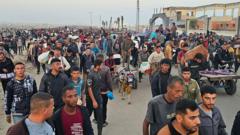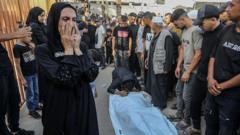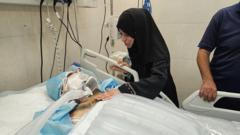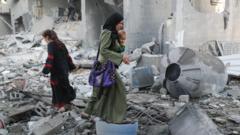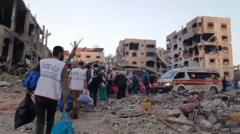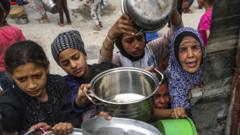In a disturbing report, the World Food Programme (WFP) describes chaotic scenes in Gaza as civilians overwhelmed aid trucks delivering much-needed food supplies. The situation has escalated following an easing of an extended blockade, yet aid remains critically insufficient to meet the population's dire needs.
Desperate Crowds Rush Gaza Food Trucks Amid Ongoing Crisis

Desperate Crowds Rush Gaza Food Trucks Amid Ongoing Crisis
Food aid trucks face chaos as desperation rises among Gazans struggling with severe hunger, the World Food Programme warns.
On Saturday, the WFP announced that 77 trucks carrying flour arrived in Gaza, only to be overwhelmed by desperate crowds eager to feed their families. Instead of proceeding to distribution points, the trucks were stopped along their routes by civilians who had learned of the incoming food supplies. WFP spokeswoman Abeer Etefa stated that the organization opted to allow people to take food directly from the trucks due to the high probability of convoys not reaching their intended destinations.
Since the partial lifting of the blockade on May 19, the flow of aid into Gaza has been significantly inadequate, reaching only about 10% of the population’s daily requirements. "After nearly 80 days of a total blockade, starving people will not let a food truck pass," WFP remarked, highlighting the urgent crisis facing nearly two million individuals in need. Etefa added that despite some aid distribution efforts, they fall woefully short of what is necessary to manage the rising tensions and chaos.
While Israel contends that the blockade is intended to pressure Hamas regarding remaining hostages, criticism has surfaced concerning the limited humanitarian response available to the populace. UN officials echoed these concerns, expressing that only 900 trucks of aid dispatched last week were a fraction of what is necessary. Additionally, tensions between Israel and the UN regarding aid distribution have intensified, with Israeli officials accusing the UN of failing to efficiently deliver aid already situated in Gaza.
Amid this turmoil, a new initiative backed by the US and Israel has attempted to implement aid distributions in conflict zones. However, this effort has faced significant challenges, including claims of aid being diverted by organizations including Hamas. Additionally, the United Nations has refrained from collaborating with this operation, deeming it contrary to humanitarian principles.
As the humanitarian crisis develops, the violence continues, with the Israeli Defense Forces reporting ongoing airstrikes targeting supposed Hamas sites. Casualty figures released by Gaza's health ministry indicate a steep death toll, with indiscriminate attacks contributing to the burgeoning humanitarian disaster.
Furthermore, an international diplomatic gathering meant to engage with Palestinian authorities has been undermined by Israel's refusal to allow the visit, further complicating efforts to achieve peace in the region.
As the conflict enters its second month, the harsh realities of life and survival in Gaza remain marred by violence, hunger, and the looming threat of famine.
Since the partial lifting of the blockade on May 19, the flow of aid into Gaza has been significantly inadequate, reaching only about 10% of the population’s daily requirements. "After nearly 80 days of a total blockade, starving people will not let a food truck pass," WFP remarked, highlighting the urgent crisis facing nearly two million individuals in need. Etefa added that despite some aid distribution efforts, they fall woefully short of what is necessary to manage the rising tensions and chaos.
While Israel contends that the blockade is intended to pressure Hamas regarding remaining hostages, criticism has surfaced concerning the limited humanitarian response available to the populace. UN officials echoed these concerns, expressing that only 900 trucks of aid dispatched last week were a fraction of what is necessary. Additionally, tensions between Israel and the UN regarding aid distribution have intensified, with Israeli officials accusing the UN of failing to efficiently deliver aid already situated in Gaza.
Amid this turmoil, a new initiative backed by the US and Israel has attempted to implement aid distributions in conflict zones. However, this effort has faced significant challenges, including claims of aid being diverted by organizations including Hamas. Additionally, the United Nations has refrained from collaborating with this operation, deeming it contrary to humanitarian principles.
As the humanitarian crisis develops, the violence continues, with the Israeli Defense Forces reporting ongoing airstrikes targeting supposed Hamas sites. Casualty figures released by Gaza's health ministry indicate a steep death toll, with indiscriminate attacks contributing to the burgeoning humanitarian disaster.
Furthermore, an international diplomatic gathering meant to engage with Palestinian authorities has been undermined by Israel's refusal to allow the visit, further complicating efforts to achieve peace in the region.
As the conflict enters its second month, the harsh realities of life and survival in Gaza remain marred by violence, hunger, and the looming threat of famine.

